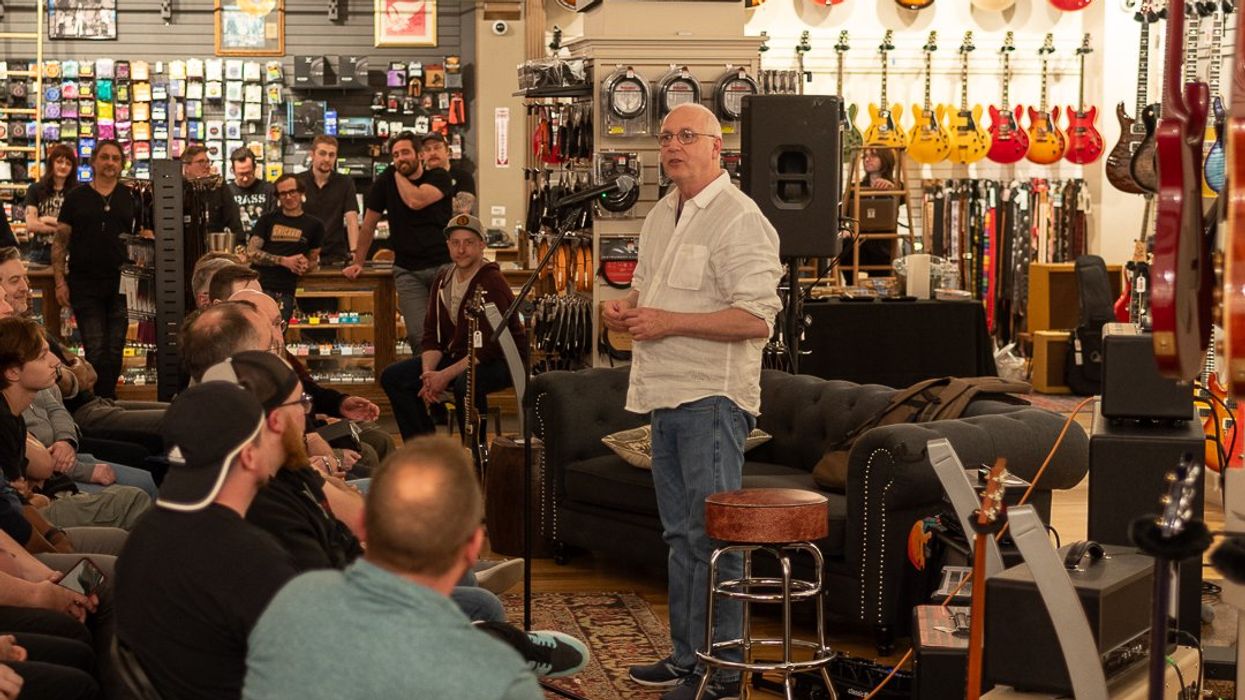Paul Reed Smith: A Builder's Perspective
02 Jul 2025

For the past year, Paul Reed Smith has written monthly articles for Premier Guitar's Pro-Advice series called "A Builder's Perspective." Each article aims to demystify a portion of the guitar making process and associated business practices. Get a quick overview of each of Paul's twelve articles, or click in to read his full thoughts on any of the topics you find most interesting!
1. “Tonewood” Doesn’t Matter. Wood Does.
Paul's first article tackles the hot topic of how "tonewood" affects the final product while building a guitar. In it, he shares the qualities he looks for in different species and pieces of wood so he can make the most musical instrument possible, but also how his understanding of the guitar building process has changed since beginning his journey four decades ago. To him what ultimately matters is not the reputation a certain variety of wood has, but how each piece of the guitar performs a different job to make a long lasting, good soudning instrument.
“While the tonal differences in electric guitars start acoustically, they carry through when the guitar is plugged in.”
2. Is That Guitar Worth the Price?
Buying a guitar can be intimidating, from picking the right model for you to deciding what a good price point is. Paul shares his thoughts on how the internet has become a great tool to help you understand what the general consensus on a guitar is, not to mention the return policy on guitars you buy online! In all, whether or not a guitar is "worth it" varies from person to person and how you want to use the guitar. Paul's biggest piece of advice when unsure about whether or not a guitar is worth it to you? Hold it in your hands and play it!
"So, the question about gear and prices is: Are you getting your money’s worth? In other words, can you use the instrument at rehearsal, at a gig, in a concert, in a recording studio?"
3. What You Can and Can’t See When Buying a Guitar
There's exhaustive material out there to tell you the things you should look for when you are trying to buy a new guitar, but what about the details you can't see? There is a level of trust a buyer has to have in the guitar maker to buy an instrument without being able to see some of the most important details that will impact your playing experience. That's where reputation comes into play, a big point of pride for Paul as a maker of fine guitars.
"If an instrument is built really well, your experience of playing it will give you a good indication of how well the things you can’t see were done."
4. Does Where a Guitar is Made Really Matter?
Here at PRS we have spoken at length about the importance of our relationship with overseas partners. Many of our SE models are manufactured by Cor-Tek in Indonesia, but the country of origin makes no difference when it shares the same name on the headstock as an American made guitar. Paul highlights the idea that where an instrument was made has no impact on how it sounds or plays, a great guitar can come from overseas just as much as a terrible one can be made right here in America!
"I’ve always believed that it’s not about the country that an instrument is made in. It’s always been about the skill level of the guitar makers."
5. The Complicated Beauty of Electric Guitar Pickups
Pickups are a core component in what give electric guitars their unique voicing, so the small details in wire thickness, turns, and more, are each important factors that dictate the character of a particular pickup. These fine-tuned magnets are studied and tested endlessly by guitar makers, but for the average player the only question they have to have answered is whether or not you like the voice of a particular pickup.
"In the end, it’s really simple. Do you like the sound of the pickup? Will it do the job that you’re looking for the instrument to do?"
6. In Guitar Making, It’s the Details that Matter
A good guitar looks or sounds good, but a great guitar is the combination of feeling good, playing well, staying in tune, and countless other details that go into making an addictive to play instrument. Paul points out only three of those details in this article, but emphasizes why there is so much focus on smaller details that a player might not even notice the first several times they handle or play a guitar.
"If it looks good, you’ll probably pick it up. If it feels good in your hands and rings for a long time when you strum it acoustically, you’ll probably plug it in. If it sounds good plugged in, there’s a good chance you’re hooked."

7. When Building Guitars—or Pursuing Anything—Go Down All the Rabbit Holes
Learning isn't a passive experience for Paul Reed Smith, it's not listening to lectures hoping to retain information, rather he views learning as a life long task you have to continuously toss yourself into. It can be one-on-one instruction from a teacher to get an inside look at how they perform their craft, but it can also be legacy in the form of instruments made by legends of the past, leaving their lessons in the guitar (or violin!) itself. There's so many things that go into becoming "great" that you have to be passionate about every detail of the manufacturing process--and not being afraid to dedicate some time to going down a few rabbit holes along the way.
"You don’t become a master of your craft by happenstance; you stay deeply curious and have an insatiable will to learn, apply what you learn, and progress."
8. Paul Reed Smith on Buying Gear
The experience of buying gear has changed dramatically since the advent of the internet, content creators, and countless review outlets. Years ago you might have picked a guitar because your favorite artist played one, or an ad piqued your curiosity, but nowadays the ability to compare and contrast models can become overwhelming especially to novice players. The key advice you should be taking away is that there is no "right" answer on what guitar you should buy, only what guitar is right for you.
"So, here’s my challenge to you: Next time you’re thinking about a new piece of gear, go to a store and try it out. Let yourself experience it fully. Feel how it plays, listen to its tone, and let your instincts lead the way. "
9. Learning from the Mistakes of Guitar Building’s Past
Paul Reed Smith credits a lot of his knowledge on building great guitars from fixing broken ones. Seeing the ways in which an instrument failed, and which ways they seem to fail most frequently, informs a builder on how they can fix that problem in future models. He lists a few of the more prevalent issues he has seen over the years, but it really calls to mind the idea that mistakes, while inevitable, are truly one of the greatest teachers if we take the time to understand our failures--which goes way beyond just guitar making!
"Repairing guitars is an unbelievable way to learn how to design an instrument that repair people and road techs won’t struggle with, because you get to see firsthand all the ways the guitars on your bench failed. "
10. Paul Reed Smith on Where Amp History–and Tone–Begins
An electric guitar feels incomplete until it's paired with an amplifier that can really dial up the tone you're looking for in your instrument. Amplifiers have evolved a great deal since their invention in the early 1900's, with many designers tweaking early designs in order to create new tonal options. Paul explores the ways in which the amplifier business is just as complex as the guitar business, though reiterates that despite their complexity there's nothing like finding an amp to help your instrument sing.
"In a way, you’re trusting the amp designers to understand all the highly complex variations from history, and then make a product that you love playing through. It’s daunting, but I love it."
11. The Lifelong Rhythm of Learning
Reflecting on 40 years of PRS Guitars, Paul credits his love for learning as part of why he continues to innovate and how there will always be more work to be done. A great lesson he shares is that he has no regret for the things he didn't know in his youth, only appreciation for the knowledge he's gleaned along the way, and the things he will continue to learn as time goes on.
"If profound learning comes late in life, so be it. The important thing is to remain open to it when it arrives."
12. Paul Reed Smith: My Year Writing for Premier Guitar
In his final article for Premier Guitar, Paul gives his own brief overview on each of his previous installments to the "Builder's Perspective" series, but also his enjoyment in shining light on the guitar industry as a whole.
